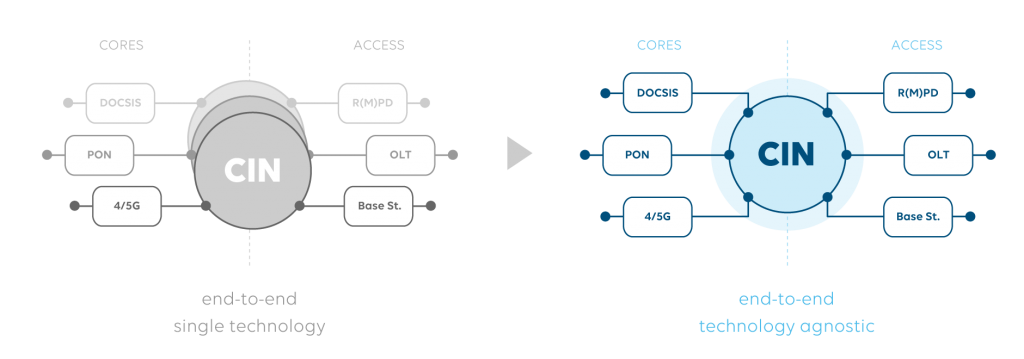Mixing it up: Hybrid is the norm
The days when service providers were categorized according to their access technology are already long gone. Today, hybrid access infrastructures have become the norm, and for several different reasons too. That’s why the need for a new networked structure, the Converged Interconnect Network (CIN), arises. But before we go into that, let’s talk about those reasons.
First of all, there are the ongoing mergers and acquisitions in the service provider industry. Seeking to add revenue generating units (RGUs) or increase the revenue per user (ARPU), quite a lot of former independent players in fixed and/or wireless service spaces have consequently merged into a bigger player.
Secondly, there’s the reality that there is no such thing as a single technology that is able to support all customer segments and use cases. Over the years, service providers have gradually introduced new access technologies to deliver, for example, community WIFI, fixed wireless or business services. And although 5G is often perceived as the answer to all emerging use cases in the context of IoT, this technology (just like any other) also has its weaknesses and susceptibilities. That implies the next technology is already in the making, targeted to hit the market around 2025. And that new wave of transition will by no means be the end point.
The Converged Interconnect Network introduced
Driven by the need to increase the capacity per end terminal or end user, service group and cell size are shrinking across all access networks. Consequently, service providers have to move the service nodes deeper into the network, and that applies to all access networks they operate.
The answer that removes all difficulties: network convergence. If you want to maximize the return on every wavelength, leased fiber strand or deployed fiber cable, and to rationalize the cost of the rollout, operation and capacity upgrades, you are looking at network convergence.
The new converged, distributed access architecture (DAA) is built around that, with at its center a converged interconnect network (CIN). As its name suggests, the CIN supports the interconnection of service cores and nodes, and delivers the fronthaul/backhaul capacity as required for all access technologies as deployed.
As it delivers transport and aggregation functions, the converged interconnect network (CIN) often has a spine-leaf architecture. The spine component typically shows 100GbE interfaces, supports the transport function and aims to maximize the throughput of every fiber segment. On the other hand, the leaf components on both ends of the spine aggregate control and data flows from the respective service cores and nodes.
What’s ‘special’ about this new networked structure is that it supports straightforward extension with additional cores and one-click changes to core node associations. This is very convenient to support use cases such as core protection or migration, reduction of logical node or cell size, or a temporary need for additional node capacity.
Three dimensions’ a charm. Or is it?
Time now to spend a few words on the impact of the introduction of this new converged interconnect network (CIN). What are the characteristics and operations around this and how do you assure quality of service to the end user?
First of all, the possibility to add or alter node-core associations with the click of a button results in an unprecedented level of agility in operations. All information related to cores, nodes, services, connections and associations becomes subject to change over time. And with time added as a third dimension, it has become impossible to proceed with offline documentation. It is mandatory to migrate to a setup that allows you to “read” straight from the network.
Also, just like the traditional access components, the elements of the newly added converged interconnect network (CIN) are subject to failure. On top of that, it’s important to realize that they add a full suite of new key performance indicators (KPIs) that will need to be tracked because they interfere with the quality of service (QoS) at the end user. Switch/router as well as link-related KPIs all represent a possible cause of added delay, jitter, packet loss, which either directly or indirectly leads to errors or loss of service.
As far as management is concerned, integration is definitely the way forward; holding on to a siloed approach is simply a recipe for disaster. Let’s say you depend on a swivel chair process adding offline correlation of incidents in one subsystem and status information in another. This leaves you without a chance to deliver to your SLAs and similar difficulties apply for monitoring, e.g. resource utilization or capacity planning.
Integrating the management per single service only, operators face duplicate integrations and challenging operations around the converged interconnect network (CIN) itself. To proceed with this kind of ‘point’ platforms for every access technology is far from efficient.
Then why fuss over the Converged Interconnect Network (CIN) if it’s so difficult?
Because it really doesn’t have to be: It’s all about knowing how to use it. Of course, the components in the converged interconnect network (CIN), just like the access specific components, feature their own element/network management system. But as said, that doesn’t mean you have to go for a siloed approach. You’ll only end up with a limited visibility and you will be unaware of the status of the other components, or worse, completely service unaware.

On top of that, it is unsustainable to proceed with ‘point’ platforms per access technology. Fortunately, DataMiner is perfectly suited to cover your entire DAA setup end to end, irrespective of the technology, supplier or implementation.
The platform assists you from service launch to termination, in areas such as service orchestration, network/service monitoring, fault finding, service restoration, platform optimization, capacity planning, etc. As such, it becomes irrelevant how many different fixed, wireless or mobile networks and services you operate. It’s all based on a single integration of the converged interconnect network (CIN).